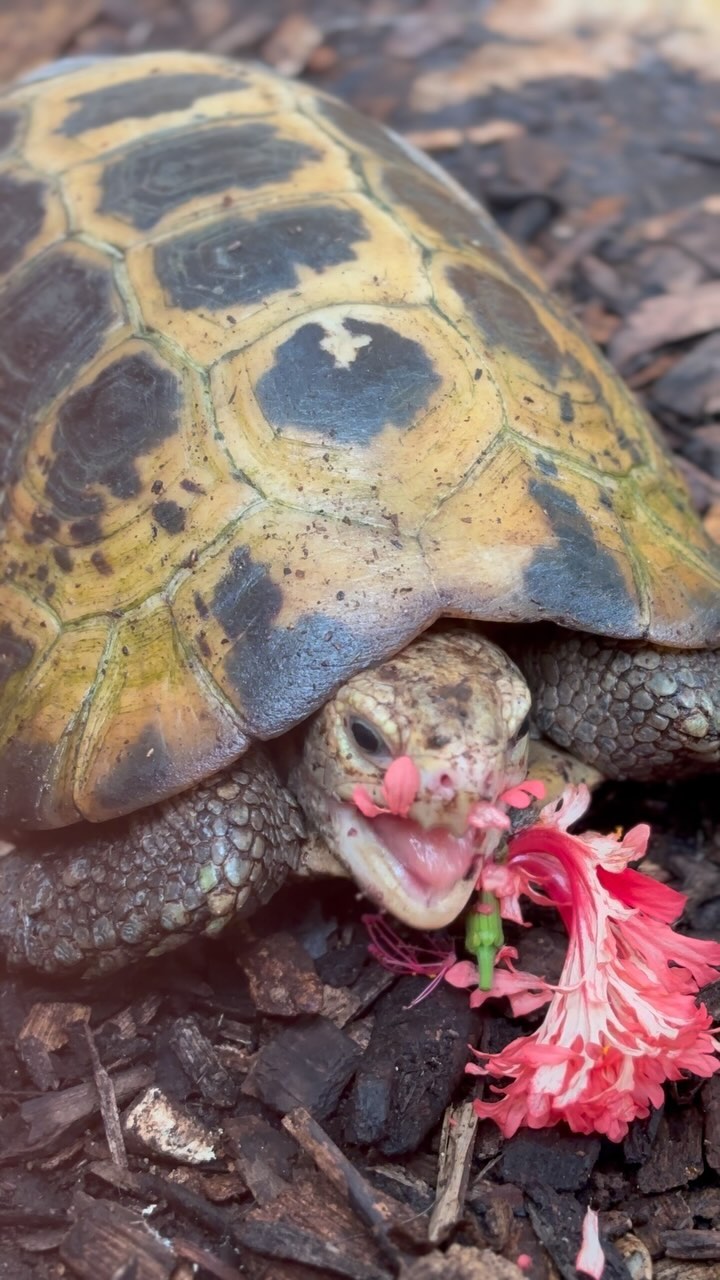– The cultivation and nutritional significance of edible plants for turtle diets.
– Forsten’s Tortoise: A species profile and conservation status.
– The role of captive breeding and habitat simulation in wildlife conservation efforts.
– The importance of public awareness and education in promoting endangered species protection.
– Integrating horticulture with zoological management for animal welfare and biodiversity conservation.
Edible Plants and Turtle Nutrition
Feeding habits play a crucial role in captive turtle populations’ health and longevity, such as those found in sanctuaries and conservation centers. At the Turtle Survival Center, the dietary regimen for creatures like the Forsten’s Tortoise is meticulously planned and executed—a philosophy rooted in replicating natural diets to promote well-being and vitality among these reptiles. Turtles, known for their vegetarian tendencies, often feast on a vast array of botanical offerings, with edible petals forming a delightful part of their diet.
Edible plants like hibiscus flowers, dandelions, and various lettuces are cultivated specifically for turtle consumption. These plants are chosen carefully for their nutritional properties, which include essential vitamins, minerals, and fiber. Such nutrients are pivotal to shell health, digestion, and overall physiological functioning. Hibiscus, for example, is appealing for its vibrant color, high vitamin C content and palatable taste, which turtles find particularly enticing.
Forsten’s Tortoise: Species Profile and Conservation
Forsten’s Tortoise (Indotestudo forstenii), a striking reptile, is native to the Indonesian islands of Sulawesi and Halmahera. It bears a domed shell with a distinct coloration that affords it a degree of camouflage in its natural forest floor habitat. The species, however, finds itself teetering on the brink of extinction—designated as “Critically Endangered” on the IUCN Red List, primarily due to habitat destruction and the illegal wildlife trade.
In the face of these threats, captive breeding programs and specially designed habitats become pivotal for the sustenance of this species. By mimicking the ecological parameters of their natural environments, conservationists can cater to the behavioral and dietary needs of the Forsten’s Tortoise. This unique tortoise exhibits specific preferences for certain food types, among which the hibiscus flower is a frequent selection; by offering such foods, captive environments aim to promote natural grazing behavior and nutritional health.
Habitat Simulation in Wildlife Conservation
Creating a semblance of a tortoise’s natural habitat within a controlled environment such as a greenhouse is more than just an aesthetic undertaking; it’s a critical element of the species conservation strategy. Simulating natural habitat factors such as temperature, humidity, and flora serves a dual purpose. On the one hand, it helps to stimulate natural behavior patterns and breeding in species like the Forsten’s Tortoise; on the other hand, it acts as a research tool for scientists to study and understand the conditions necessary for the growth and propagation of these species in captivity.
The scaled-down representation of a tortoise’s native environment also provides valuable data for in-situ conservation efforts. By witnessing how the tortoise interacts with the horticultural elements, wildlife managers can gain insights into restoring and rehabilitating wild populations and their habitats more effectively.
Public Awareness and Endangered Species Protection
Education is a potent force in the battle to save species like the Forsten’s Tortoise from extinction. Through platforms like social media and live exhibits, conservation centers can provide the public with a digital window into the lives of these amazing reptiles, fostering empathy and a deeper understanding of the critical importance of biodiversity preservation. When people are encouraged to learn about the specific dietary habits and environmental needs of the Forsten’s Tortoise, they become more likely to support and engage in conservation programs.
In addition to generating support, education is a deterrent against the illicit trade of endangered species. By understanding the consequences of removing animals like the Forsten’s Tortoise from their native environment, potential consumers are dissuaded, and demand for illegally procured wildlife diminishes.
Horticulture and Zoological Management
A multidisciplinary approach merging horticulture with zoology has proven beneficial for both plant and animal species in conservation centers. As turtles enjoy petals for lunch, the choice and care of these plants reflect a broader commitment to ecological systems. This approach also ensures that captive breeding programs do not operate in isolation but are deeply interconnected with broader ecosystem health and resilience.
Horticultural experts must also be conscious of sustainability when cultivating edible flora. This means selecting plant varieties that can thrive in the given environmental conditions with minimal resource inputs, avoiding harmful pesticides, and implementing organic practices whenever possible. By doing so, these greenhouses and gardens provide nourishment for creatures like the Forsten’s Tortoise and serve as models for sustainable agriculture and conservation practices that could be replicated in other settings.
In summary, the turtle’s diet, including petals like those of the hibiscus flower, underscores a comprehensive approach to conservation that encompasses nutrition, habitat simulation, public education, and integrated management practices. Such endeavors are essential to ensure the survival and well-being of species like the Forsten’s Tortoise, ultimately contributing to global biodiversity conservation efforts. Through careful planning and implementation of these practices, conservationists hope to see these captivating creatures thrive well into the future.
*****
Source Description
Petals for lunch, anyone?
We grow various edible plants for the turtles residing in the Greenhouse at our Turtle Survival Center. This snacky Forsten’s Tortoise chows down on a hibiscus flower in its habitat, miming the natural environments from which these species originate.
Pictured: Forsten’s Tortoise (Indotestudo forsterite)
Red List Status: Critically Endangered
🎥: Elena Duran


